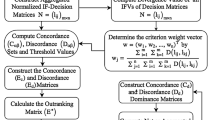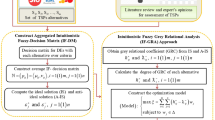Abstract
The objective of this paper is to construct an outline to explore the performance of cellular mobile telephone service providers (TSPs) in the Madhya Pradesh (MP) (including CG) circle, India. The data for the analysis has been considered from the Telecom Regulatory Authority of India (TRAI), Jan–March 2017. Most of the data fluctuate from month by month. As a result, these small deviations in the data are integrated in the current research with the intuitionistic fuzzy numbers (IFNs). The present research employs an intuitionistic fuzzy Weighted Aggregated Sum Product Assessment (IF-WASPAS) method to compare the performance of TSPs. Proposed method is based on the IFSs operators, and a new method for calculation of criteria weights. For the computation of criteria weights, we aggregate the subjective weights articulated by the decision experts with the objective weights derived from similarity measure method to achieve more reasonable weights. To compute the objective weight, new similarity measures are developed for IFSs and demonstrated various elegant properties of the proposed similarity measures. Finally, to express the strength and applicability of the proposed method, a case study to compare the performance of TSPs is considered. Next, a sensitivity analysis with different criteria weights and various values of parameters is presented to illustrate the strength of the developed IF-WASPAS method. A comparison is discussed between the developed method and some existing ones for certifying the developed method. Present analysis demonstrates that aggregating the subjective and objective weights can facilitate to enhance the stability of the developed method with different criteria weights.






Similar content being viewed by others
References
Ansari MD, Mishra AR, Ansari FT (2018) New divergence and entropy measures for intuitionistic fuzzy sets on edge detection. Int J Fuzzy Syst 20(2):474–487
Atanassov KT (1986) Intuitionistic fuzzy sets. Fuzzy Sets Syst 20(1):87–96
Bitarafan M, Zolfani SH, Arefi SL, Zavadskas EK, Mahmoudzadeh A (2014) Evaluation of real-time intelligent sensors for structural health monitoring of bridges based on SWARA-WASPAS: a case in Iran. Balt J Road Bridge Eng 9(4):333–340
Boran FE, Akay DA (2014) Biparametric similarity measure on intuitionistic fuzzy sets with applications to pattern recognition. Inf Sci 255:45–57
Chakraborty S, Zavadskas EK (2014) Applications of WASPAS method in manufacturing decision making. Informatica 25(1):1–20
Chen SM (1995) Measures of similarity between vague sets. Fuzzy Sets Syst 74(2):217–223
Chen SM, Chang CH (2015) A novel similarity measure between Atanassov’s intuitionistic fuzzy sets based on transformation techniques with applications to pattern recognition. Inf Sci 291:96–114
Chen SM, Chen CD (2011) Handling forecasting problems based on high-order fuzzy logical relationships. Expert Syst Appl 38(4):3857–3864
Chen SM, Wang NY, Pan JS (2009) Forecasting enrollments using automatic clustering techniques and fuzzy logical relationships. Expert Syst Appl 36(8):11070–11076
Chen SM, Munif A, Chen GS, Liu HC, Kuo BC (2012) Fuzzy risk analysis based on ranking generalized fuzzy numbers with different left heights and right heights. Expert Syst Appl 39(7):6320–6334
Chen SM, Cheng SH, Chiou CH (2016) Fuzzy multiattribute group decision making based on intuitionistic fuzzy sets and evidential reasoning methodology. Inf Fusion 27:215–227
Fan L, Zhang YX (2001) Similarity measures between vague sets. Chin J Softw 12(6):922–927
Hong DH, Kim C (1999) A note on similarity measures between vague sets and between elements. Inf Sci 115(1–4):83–96
Hung SW, Lu WM (2007) A comparative study of the performance measurement in global telecom operators. Total Qual Manag Bus Excell 18(10):1117–1132
Hung WL, Yang MS (2004) Similarity measures of intuitionistic fuzzy sets based on Hausdorff distance. Pattern Recogn Lett 25(14):1603–1611
Hung WL, Yang MS (2008) On similarity measures between intuitionistic fuzzy sets. Int J Intell Syst 23(3):364–383
Hwang CM, Yang MS, Hung WL (2012) A similarity measure of intuitionistic fuzzy sets based on the Sugeno integral with its application to pattern recognition. Inf Sci 189:93–109
Intarapaiboon P (2014) New similarity measures for intuitionistic fuzzy sets. Appl Math Sci 8(45):2239–2250
Julian P, Hung KC, Lin SJ (2012) On the Mitchell similarity measure and its application to pattern recognition. Pattern Recogn Lett 33(9):1219–1223
Kumar S, Kumar YS (2013) Evaluation of comparative performance of telecom service providers in India using TOPSIS and AHP. Int J Bus Excell 6(2):192–213
Kumar A, Shankar R, Debnath RM (2015) Analyzing customer preference and measuring relative efficiency in telecom sector: a hybrid fuzzy AHP/DEA study. Telemat Inform 32(3):447–462
Kumar P, Singh RK, Kharab K (2017) A comparative analysis of operational performance of Cellular Mobile Telephone Service Providers in the Delhi working area using an approach of fuzzy ELECTRE. Appl Soft Comput 59:438–447
Lashgari S, Antuchevičienė J, Delavari A, Kheirkhah O (2014) Using QSPM and WASPAS methods for determining outsourcing strategies. J Bus Econ Manag 15(4):729–743
Lee LW, Chen SM (2015) Fuzzy decision making based on likelihood-based comparison relations of hesitant fuzzy linguistic term sets and hesitant fuzzy linguistic operators. Inf Sci 294:513–529
Li D, Cheng C (2002) New similarity measures of intuitionistic fuzzy sets and application to pattern recognitions. Pattern Recogn Lett 23(1–3):221–225
Li DF, Chuntian C (2002) New similarity measures of intuitionistic fuzzy sets and application to pattern recognition. Pattern Recogn Lett 23(1–3):221–225
Li J, Deng G (2012) The relationship between similarity measure and entropy of intuitionistic fuzzy sets. Inf Sci 188:314–321
Li F, Xu Z (2001) Similarity measures between vague sets. J Softw 12(6):922–927
Li Y, Chi Z, Yan D (2002) Similarity measures between vague sets and vague entropy. J Comput Sci 29(12):129–132
Liang Z, Shi P (2003) Similarity measures on intuitionistic fuzzy sets. Pattern Recogn Lett 24(15):2687–2693
Lu Z, Ye J (2018) Logarithmic similarity measure between interval-valued fuzzy sets and its fault diagnosis method. Information 9(36):1–12
Mardani A, Nilashi M, Zakuan N, Loganathan N, Soheilirad S, Saman MZ, Ibrahim O (2017) Systematic review and meta-analysis of SWARA and WASPAS methods: theory and applications with recent fuzzy developments. Appl Soft Comput 57:265–292
Meng F, Chen X (2014) Entropy and similarity measure of Atanassov’s intuitionistic fuzzy sets and their application to pattern recognition based on fuzzy measures. Pattern Anal Appl 19(1):11–20
Mishra AR (2016) Intuitionistic fuzzy information measures with application in rating of township development. Iran J Fuzzy Syst 13(3):49–70
Mishra AR, Rani P (2017) Shapley divergence measures with VIKOR method for multi-attribute decision making problems. Neural Comput Appl. https://doi.org/10.1007/s00521-017-3101-x
Mishra AR, Rani P (2018) Biparametric information measures based TODIM technique for interval-valued intuitionistic fuzzy environment. Arab J Sci Eng 43(6):3291–3309
Mishra AR, Rani P, Jain D (2017a) Information measures based to TOPSIS method for multi-criteria decision making problem in intuitionistic fuzzy environment. Iran J Fuzzy Syst 14(6):41–63
Mishra AR, Jain D, Hooda DS (2017b) Exponential intuitionistic fuzzy information measure with assessment of service quality. Int J Fuzzy Syst 19(3):788–798
Mishra AR, Kumari R, Sharma DK (2017c) Intuitionistic fuzzy divergence measure-based multi-criteria decision-making method. Neural Comput Appl. https://doi.org/10.1007/s00521-017-3187-1
Mishra AR, Rani P, Pardasani KR (2018) Multiple-criteria decision-making for service quality selection based on shapley COPRAS method under hesitant fuzzy sets. Granul Comput. https://doi.org/10.1007/s41066-018-0103-8
Mitchell HB (2003) On the Dengfeng Chuntian similarity measure and its application to pattern recognition. Pattern Recogn Lett 24(16):3101–3104
Nigam V, Thakur T, Sethi VK, Singh RP (2012) Benchmarking of Indian mobile telecom operators using DEA with sensitivity analysis. Benchmarking Int J 19(2):219–238
Papakostas GA, Hatzimichailidis AG, Kaburlasos VG (2013) Distance and similarity measures between intuitionistic fuzzy sets: a comparative analysis from a pattern recognition point of view. Pattern Recogn Lett 34(14):1609–1622
Pedrycz W, Chen SM (2011) Granular computing and intelligent systems: design with information granules of high order and high type. Springer, Berlin
Pedrycz W, Chen SM (2015a) Granular computing and decision-making: interactive and iterative approaches. Springer, Berlin
Pedrycz W, Chen SM (2015b) Information granularity, big data and computational intelligence. Springer, Berlin
Peng X, Dai J (2017) Hesitant fuzzy soft decision making methods based on WASPAS, MABAC and COPRAS with combined weights. J Intell Fuzzy Syst 33(2):1313–1325
Rani P, Jain D (2017) Intuitionistic fuzzy PROMETHEE technique for multi-criteria decision making problems based on entropy measure. In: Proceedings of Communications in Computer and Information Science (CCIS), Springer 721:290–301
Rani P, Jain D, Hooda DS (2018a) Shapley function based interval-valued intuitionistic fuzzy VIKOR technique for correlative multi-criteria decision making problems. Iran J Fuzzy Syst 15(1):25–54
Rani P, Jain D, Hooda DS (2018b) Extension of intuitionistic fuzzy TODIM technique for multi-criteria decision making method based on Shapley weighted divergence measure. Granul Comput. https://doi.org/10.1007/s41066-018-0101-x
Saxena V, Thakur T, Singh RP (2009) Evaluating the performance of mobile telecom operators in India. Int J Simul Syst Sci Technol 10(4):58–63
Song Y, Wang X (2017) A new similarity measure between intuitionistic fuzzy sets and the positive definiteness of the similarity matrix. Pattern Anal Appl 20(1):215–226
Song Y, Wang X, Lei L, Xue A (2014) A new similarity measure between intuitionistic fuzzy sets and its application to pattern recognition. Abstr Appl Anal 384241:1–11
Song Y, Wang X, Quan W, Huang W (2017) A new approach to construct similarity measure for intuitionistic fuzzy sets. Soft Comput. https://doi.org/10.1007/s00500-017-2912-0
Srivastava A, Maheshwari S (2016) Decision making in medical investigations using new divergence measures for intuitionistic fuzzy sets. Iran J Fuzzy Syst 13(1):25–44
Szmidt E, Kacprzyk J (2000) Distances between intuitionistic fuzzy sets. Fuzzy Sets Syst 114(3):505–518
TRAI (2017) Audit wireless report for MP (including CG) circle, Regional office Bhopal. http://www.trai.gov.in/sites/default/files/Audit_Report_MP_25072017.pdf
TRAI (April-June (2017) The Indian Telecom services performance indicators, New Delhi, India. http://trai.gov.in/sites/default/files/Performance_Indicator_Reports_28092017.pdf
Vafaeipour M, Zolfani SH, Morshed Varzandeh MH, Derakhti A, Keshavarz Eshkalag M (2014) Assessment of regions priority for implementation of solar projects in Iran: new application of a hybrid multi-criteria decision making approach. Energy Convers Manag 86:653–663
Walters SJ (2009) Quality of life outcomes in clinical trials and health-care evaluation: a practical guide to analysis and interpretation. Wiley, Chichester
Wang HY, Chen SM (2008) Evaluating students’ answer scripts using fuzzy numbers associated with degrees of confidence. IEEE Trans Fuzzy Syst 16(2):403–415
Xia M, Xu ZS (2010) Some new similarity measures for intuitionistic fuzzy values and their application in group decision making. J Syst Sci Syst Eng 19(4):430–452
Xu ZS (2007a) Intuitionistic fuzzy aggregation operators. IEEE Trans Fuzzy Syst 15(6):1179–1187
Xu ZS (2007b) Some similarity measures of intuitionistic fuzzy sets and their applications to multiple attribute decision making. Fuzzy Optim Decis Mak 6(2):109–121
Xu ZS, Chen J (2008) An overview of distance and similarity measures of intuitionistic fuzzy sets. Int J Uncertain Fuzziness Knowl-Based Syst 16(4):529–555
Xu GL, Wan SP, Xie XL (2015) a selection method based on MAGDM with interval-valued intuitionistic fuzzy sets. Math Probl Eng 791204:1–13
Yadav N (2014) Total interpretive structural modelling (TISM) of strategic performance management for Indian telecom service providers. Int J Prod Perform Manag 63(4):421–445
Yang HH, Chang CY (2009) Using DEA window analysis to measure efficiencies of Taiwan’s integrated telecommunication firms. Telecommun Policy 33(1–2):98–108
Ye J (2011) Cosine similarity measures for intuitionistic fuzzy sets and their applications. Math Comput Model 53(1–2):91–97
Zadeh LA (1965) Fuzzy sets. Inf Control 8(3):338–353
Zavadskas EK, Turskis Z, Antucheviciene J, Zakarevicius A (2012) Optimization of weighted aggregated sum product assessment. Elektron elektrotech 122(6):3–6
Zavadskas EK, Antucheviciene J, Razavi Hajiagha SH, Hashemi SS (2014) Extension of weighted aggregated sum product assessment with interval-valued intuitionistic fuzzy numbers (WASPAS-IVIF). Appl Soft Comput 24:1013–1021
Zhang H, Yu L (2013) New distance measures between intuitionistic fuzzy sets and interval-valued fuzzy sets. Inf Sci 245:181–196
Author information
Authors and Affiliations
Corresponding author
Additional information
Publisher’s Note
Springer Nature remains neutral with regard to jurisdictional claims in published maps and institutional affiliations.
Rights and permissions
About this article
Cite this article
Mishra, A.R., Singh, R.K. & Motwani, D. Multi-criteria assessment of cellular mobile telephone service providers using intuitionistic fuzzy WASPAS method with similarity measures. Granul. Comput. 4, 511–529 (2019). https://doi.org/10.1007/s41066-018-0114-5
Received:
Accepted:
Published:
Issue Date:
DOI: https://doi.org/10.1007/s41066-018-0114-5




